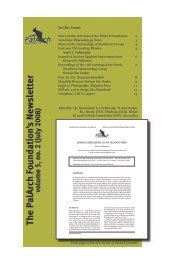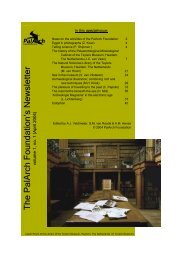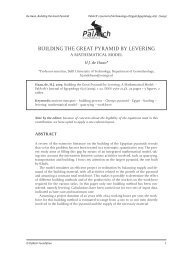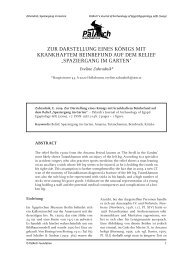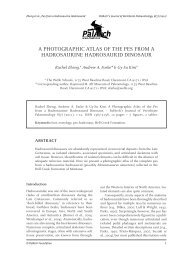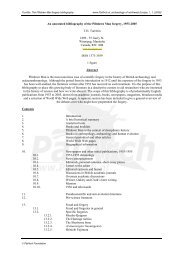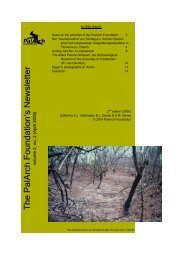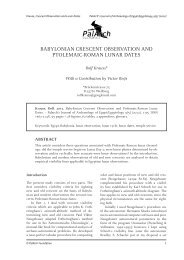neural spine bifurcation in sauropod dinosaurs of the - PalArch
neural spine bifurcation in sauropod dinosaurs of the - PalArch
neural spine bifurcation in sauropod dinosaurs of the - PalArch
Create successful ePaper yourself
Turn your PDF publications into a flip-book with our unique Google optimized e-Paper software.
Wedel & Taylor, Neural Sp<strong>in</strong>e Bifurcation <strong>in</strong> Sauropods <strong>PalArch</strong>’s Journal <strong>of</strong> Vertebrate Palaeontology, 10(1) (2013)<br />
Figure 12. Serially comparable dorsal vertebrae <strong>in</strong> different<br />
Camarasaurus species or ontogenetic stages. Left: dorsal<br />
vertebra 7 (top) and dorso-sacral (= D11) (bottom) <strong>of</strong> C.<br />
supremus AMNH 5760 and 5761 “Dorsal Series II” both <strong>in</strong><br />
posterior view, with unsplit <strong>neural</strong> <strong>sp<strong>in</strong>e</strong>s. Modified from<br />
Osborn & Mook (1921: plate 71). Right: dorsal vertebrae<br />
7-11 <strong>of</strong> C. lewisi holotype BYU 9047 <strong>in</strong> posterodorsal view,<br />
with split <strong>sp<strong>in</strong>e</strong>s. From McIntosh, Miller et al. (1996: plate<br />
5). Scaled so that <strong>the</strong> height <strong>of</strong> D11 is roughly equivalent<br />
<strong>in</strong> <strong>the</strong> two specimens.<br />
als that make up <strong>the</strong> specimen. In <strong>the</strong> geriatric<br />
C. lewisi BYU 9047 all <strong>of</strong> <strong>the</strong> post-axial presacral<br />
<strong>neural</strong> <strong>sp<strong>in</strong>e</strong>s are at least notched, and most are<br />
shallowly or deeply bifid. Even <strong>in</strong> <strong>the</strong> very posterior<br />
dorsals <strong>the</strong>re is still a dist<strong>in</strong>ct V-shaped<br />
notch <strong>in</strong> <strong>the</strong> <strong>neural</strong> <strong>sp<strong>in</strong>e</strong>, deeper and more dis-<br />
t<strong>in</strong>ctive than <strong>the</strong> very slightly bilobed <strong>sp<strong>in</strong>e</strong> tips<br />
<strong>in</strong> <strong>the</strong> posterior dorsals <strong>of</strong> C. supremus AMNH<br />
5761. Ei<strong>the</strong>r <strong>the</strong> difference between <strong>the</strong> specimens<br />
is <strong>in</strong>dividual or <strong>in</strong>terspecific variation, or<br />
some amount <strong>of</strong> ontogenetic <strong>bifurcation</strong> happened<br />
well <strong>in</strong>to adulthood; current evidence is<br />
<strong>in</strong>sufficient to falsify ei<strong>the</strong>r hypo<strong>the</strong>sis.<br />
‘Primitive’ Morphology can be an Effect<br />
<strong>of</strong> serial Position<br />
Even <strong>in</strong> ‘adult’ <strong>sauropod</strong>s like <strong>the</strong> big mounted<br />
Apatosaurus and Diplodocus skeletons (e.g. A.<br />
louisae CM 3018, D. carnegii CM 84/94), <strong>the</strong> anterior<br />
cervicals are less complex than <strong>the</strong> posterior<br />
ones. Compared to posterior cervicals, anterior<br />
cervicals tend to have simpler pneumatic<br />
fossae and foram<strong>in</strong>a, fewer lam<strong>in</strong>ae, and unsplit<br />
ra<strong>the</strong>r than bifid <strong>sp<strong>in</strong>e</strong>s (Gilmore, 1936: plate 24;<br />
Hatcher, 1901: plate 3; figure 13). In all <strong>of</strong> <strong>the</strong>se<br />
characters <strong>the</strong> anterior cervicals are similar to<br />
those <strong>of</strong> juveniles <strong>of</strong> <strong>the</strong> same taxa, and to those<br />
<strong>of</strong> adults <strong>of</strong> more basal taxa. So serial position<br />
recapitulates both ontogeny and phylogeny. This<br />
is also true <strong>in</strong> pro<strong>sauropod</strong>s – <strong>in</strong> Plateosaurus<br />
engelhardti SMNS 13200, <strong>the</strong> diapophyseal lam<strong>in</strong>ae<br />
develop <strong>in</strong> a stepwise fashion <strong>in</strong> successive<br />
cervical vertebrae (figure 14).<br />
Figure 13. Cervical vertebrae <strong>of</strong> Diplodocus carnegii CM 84/94 <strong>in</strong> right lateral view. Note <strong>the</strong> <strong>in</strong>creas<strong>in</strong>g complexity <strong>of</strong> <strong>the</strong><br />
lam<strong>in</strong>ae and pneumatic cavities <strong>in</strong> successively posterior cervicals. From Hatcher (1901: plate 3).<br />
© <strong>PalArch</strong> Foundation 14



